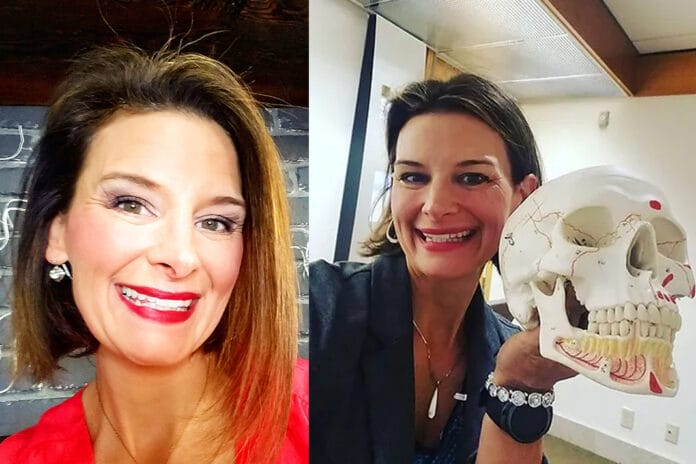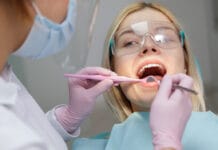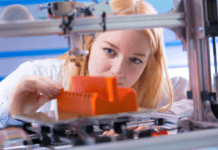When dental hygienists hear the words ‒ hygienist, educator, local anesthesia, basic life support and CPR-certified instructor ‒ who do they think of? Tina Clarke, RDH, MEd, truly fits all of these roles well.
You may be familiar with her as Teacher Tina RDH, going live every Tuesday on social media. She speaks on all things clinical hygiene, including local anesthesia, which is one of her passions. I had the privilege to connect with Tina and learn about her dental career journey. During the interview, she discussed how she became a dental hygienist, becoming the only non-educational entity in Oregon to be an Oregon-board-approved provider for local anesthesia certification, and creating Teacher Tina RDH.
Machado: What made you decide to become a dental hygienist? What is your why?
Clarke: It all started with a conversation with my hygienist, Kelli Jaecks, at the time. I was about 20 years old, and she asked if I was in school or working. It was the perfect question at the perfect time. I was working at a boring job and began looking in the employment ads in the newspaper. Yes, very old-fashioned, but it was the 1990s. I saw a lot of openings for dental assistants and a few for dental hygienists.
Little did she know I had a lot of questions for her. I was looking for a job that satisfied my desire to work with people and my interest in science, specifically biology. Fast forward 22 years, and I am still in the career because of the joy it brings knowing my words and actions impact somebody else in a positive way.
Machado: How many years have you been a dental hygienist? Educator?
Clarke: I graduated from Oregon Health Sciences University in 2001 and have been working clinically ever since ‒ so 22 years. I began teaching dental hygiene students in 2007, about 16 years ago.
Machado: You recently became a certified BLS/CPR instructor. What factored into making that decision to become a certified instructor?
Clarke: There was a major event in my life while I was taking my prerequisite courses for dental hygiene. While driving home from school, there was a flash hail storm. The interstate was covered with the white, little hailstones in a matter of minutes. Then right before my eyes, cars were flying off the road and running into each other.
Thankfully, I missed being a victim of the accident, but I witnessed everything and was the first person on the scene. At that moment, I wanted to help but didn’t know what I should do. I felt lost and horrible that I didn’t have the basic skills to help these people who needed extreme aid.
From that moment, I wanted to have the knowledge and resources to help in that type of situation. So I went through the CPR/first aid courses available. Then when I began teaching dental hygiene students, I had the opportunity to teach medical emergencies, and the idea was born to become a certified BLS/CPR instructor. It was a dream I had for nearly 10 years before making it a reality.
Machado: What is involved in becoming an instructor?
Clarke: Once someone has decided they have the passion for becoming an instructor, the first step is to find a training center. You can find a center with a simple Google search or a look at the American Heart Association. I was fortunate enough to connect with the CPR Sisters who have been providing CPR/BLS education for decades. One of the founders, Debra Carrier, is a dental hygienist. I felt it was meant to be for me to be trained by someone who also understands my knowledge and background.
Once you’ve committed to a training facility, there are courses to take, supplies to purchase, and several moments when your skills as an instructor are assessed. I had to sign up with an American Heart Association-approved training site and find a training program that worked with my schedule. I had to purchase the instructor training manual and complete a detailed knowledge assessment of the manual.
Also, I attended several educational sessions with the CPR Sisters. They demonstrated the process of teaching the course and had each student demonstrate their capacity to perform the skills and teach them in our learning group. Once this was completed, I think it was about 10 to 15 hours of learning. I don’t remember exactly how long, but it was about four or five sessions, each about two to three hours long.
I had to lead a CPR/BLS class while supervised. This was a legit class in which the attendees actually received their certification. It was a lot of pressure and a lot of responsibility.
The items I purchased were mannequins, both adult and infant, a training AED, training ambu-bags/masks, and pouches for the fake lungs in mannequins.
Once you’ve become certified, there are yearly knowledge and educational requirements as well.
Machado: What are the requirements for dental professionals in terms of BLS/CPR in our profession?
Clarke: The minimum needs to be every two years. But I recommend a review annually. It doesn’t have to be recertification but a simple review of the protocols and how one would handle a situation.
There are several online courses available. But having a course where you have hands-on experience is vital. Research supports that when hands-on learning happens, the information is retained at a greater level. Also, we forget how hard and fast we need to compress the chest. Getting to practice on a dummy is very helpful.
Machado: How did Teacher Tina RDH come about?
Clarke: The name Teacher Tina was born from one of my work colleagues. If there was a question, she would always say, “Let’s ask Teacher Tina what she thinks.” From that point on, the name stuck, and I liked it as a name for my Instagram account, which I wanted to focus on educational content for dental hygienists.
I asked her one time why she called me “Teacher Tina,” and she said that a teacher is someone who helps you understand and will find different ways to connect the information. A teacher is someone who truly cares about their students. I really liked that description, and it is something that I aspire to do on a regular basis.
The primary focus was ‒ and still is ‒ tips about the administration of local anesthesia. This quickly became an area of interest for me and something I had the skill set to teach. I learned local anesthesia while I was a student at Oregon Health Sciences University. Jill Mason was my anesthesia instructor, and I’ve been administering it ever since.
I will say that I’ve always enjoyed this aspect of dental hygiene treatment. Even when I was in school, I commented on how much I loved the course and that it wasn’t really too bad. Some of my classmates thought I was crazy. It wasn’t until I started teaching dental hygiene students in 2007 that I realized how passionate I was about this particular skill set.
It wasn’t long before people outside of the educational setting started asking me questions and seeking advice on different injections or different anesthetic situations.
Machado: Can you also describe what Teacher Tina RDH is?
Clarke: Teacher Tina RDH is a platform where oral health professionals can go to gain hints and tips on different clinical skill sets. In 2020, the business of Teacher Tina RDH became a reality.
After teaching in the traditional dental hygiene environment and providing CE courses, I realized there are more people out there like me who forgot how much they learned while in school. So I decided to start a social media presence sharing some of this information.
In the early days, I posted about a few different items, but every time I posted something about anesthesia I was inundated with questions, comments, and concerns. It’s been slowly growing ever since. I think because I have the desire to understand how people learn and work at meeting those different needs, it keeps me readily engaged and showing up.
Seeing how people responded to the information I freely sent out encouraged me to take the idea of Teacher Tina RDH from just a social media page to a learning platform where oral health professionals can gain the resources they need.
I was lucky enough to already have an online learning platform prepared and ready to go when the pandemic hit. It was the push I needed to launch it into the dental world. It started with the course “Back to Basics: Head and Neck Anatomy” and was followed by my most popular course, “Hit Me with Your Best Shot.”
Thankfully, online/digital learning has been a part of my educational life since I started teaching. I’ve used several different digital platforms, also known as learning management systems or LMS for short. I will say when I first started, it was a lot of trial and error with my college dental hygiene students. I found that when my students could access my recorded lectures, they could not only retain the information but also apply the knowledge and skills they learned.
When I decided to create my own courses, I looked to see what LMS were available outside of the collegiate setting. Once I found an LMS I liked, I simply used the same curriculum format for the on-demand courses.
After creating these courses and finding the platform to share them, the next step was to become an approved continuing education provider. I decided to undergo the process of having my business become an approved provider by the American Academy of Dental Hygiene. This allows those who take courses through my business to count as CE if their state board recognizes the AADH as a certification entity.
Machado: I live on the East Coast, so I love to learn about other states’ scope of practice and the educational requirements needed to practice. What are the current requirements for Oregon dental hygienists regarding local anesthesia certification?
Clarke: According to the Oregon Board of Dentistry (OBD), for a dental hygienist to gain their local anesthesia endorsement, they had to graduate from an accredited dental hygiene program that also included local anesthesia education in their program. For hygienists who went to schools in which that was not a part of their curriculum, such as Texas, they may not have received that education. If that is the case, they must attend an OBD-approved course.
Oregon dental hygienists have had the right to administer local anesthesia since 1975 under general supervision. Meaning the dentist can be out of the office, and the dental hygienist can still provide comprehensive dental hygiene services. One thing unique about Oregon compared to other states is the clinician does not need to take a board examination to obtain their anesthesia endorsement. Approved education is all that is required.
Each state has different requirements, as well as different scopes of practice. In Oregon, if the clinician meets the needs I highlighted earlier, they must complete the anesthesia course which is a minimum of 21 hours total, including six hours of hands-on experience.
Machado: You have such a wealth of knowledge when it comes to local anesthesia. You have been described as currently being the only non-educational entity in Oregon to be an Oregon-board-approved provider for local anesthesia certification.
You give credit to a colleague and mentor who was on the Board of Dentistry that saw a need and created this program. Your mentor was truly the first, and you took this program over.
Can you share your journey to becoming the only non-educational entity in Oregon to be an Oregon-board-approved provider for local anesthesia certification?
Clarke: Currently, some educational institutions or dental hygiene programs have Oregon board approval but don’t offer the course unless you are a currently enrolled student. Because I am outside a dental hygiene program, for example, that makes me a non-educational entity. With the assistance of my predecessor, Jill Mason, I was able to submit the curriculum, along with my qualifications, to the board to gain approval.
I do want to clarify that there are other educational entities that aren’t a part of the traditional educational institutions that have this qualification, but they are all out of state, and I am unsure if they are still providing courses. I am the only entity residing in Oregon that has the capacity to perform this, but I am not the first.
The first person is a former instructor of mine, Jill Mason. Several years ago, maybe 15, she recognized a gap in the state that needed to be filled. At that time, several states in the U.S. did not allow dental hygienists to provide local anesthesia. She was a pioneer, created a course, and went through the vigorous process of becoming an approved provider. A couple of years ago, she and I reconnected.
Since we are both passionate about anesthesia and helping others, she was able to help me with the process. It was a nail-biting experience, for sure!
One of the things I like about doing this is I am able to work with the hygienist and their schedule. It’s not an easy course to take. It’s just like the course one would take in college, but I have the freedom of flexibility. The students have modules they must complete and meet with me virtually weekly to review the information and ask questions. Then they have an in-person, hands-on experience, demonstrating their physical competence along with a written examination.
Machado: Speaking of local anesthesia, what is your favorite component of local anesthesia? Do you have a favorite injection?
Clarke: One of the best things about local anesthesia delivery is that I know my patient is comfortable with the procedure they are about to undergo. Being able to confidently perform the oral health service while knowing my patient is comfortable allows me to give them my best work.
I know it seems funny, but I do have a few favorite injections. The first one is the AMSA. The anterior middle superior alveolar injection is a palatal approach to anesthetizing the pulps and facial gingiva of premolars to the midline and the majority of the hard palate of the side injected. It doesn’t impact the patient’s lip either. They have full lip function, meaning they can go about their day without worrying about a droopy lip.
For mandibular injections, I like the Gow-Gates because it’s so reliable, but the Vazirani-Akinosi injection is gaining more of my love lately. It is so kind to the patient. They don’t have to open their mouth wide, and they barely even feel the injection. The learning curve is fairly steep, but when you have it nailed down, it feels great!
Machado: Do you have any local anesthesia secrets or helpful tips?
Clarke: Oh man, I have so many tips that it’s hard to narrow it down. I will say that most questions I receive revolve around the inferior alveolar injection. Specifically, achieving adequate anesthesia or not achieving anesthesia at all. The biggest mistake I see with this injection is people inserting and depositing too low and missing the IA nerve altogether.
So my favorite tip for this is to use the linea alba, bite line, as a landmark. If the height of insertion is about level with this line, the clinician is more likely to hit the right spot.
Machado: What would you say is the most common mistake or misconception with local anesthesia?
Clarke: I would say a common misconception is that all of our patients will reject being anesthetized when they actually don’t want to be in pain and are happy to have whatever needs to be done to be comfortable.
Another thing I see or hear is the clinicians’ fear of giving injections influencing their approach to patient care. I often have clinicians tell me they are afraid of missing the target and having to do it over again, or they are concerned about harming the patient.
I want to quote something that Sam, a clinician who took my on-demand course “Hit Me With Your Best Shot,” shared with me: “I recently just got hired into a perio practice where I have to give local anesthesia daily. Before, I worked at a general practice and hardly ever gave it and definitely wouldn’t give the IA. I didn’t get the practice in school that I needed due to the pandemic. So when I saw this course and signed up and it’s been my lifesaver.”
“It is so helpful you get access to these videos for a year to look back at them. Also, Tina has videos every Tuesday on her Facebook page on topics and once a month to really help you if you have questions or just gain more knowledge on certain topics. I highly recommend this course to anyone who is struggling with giving LA to their patients.”
I’ve also seen some clinicians shy away from administering injectable anesthesia because of their own personal fears of needles. You combine that with the patient’s own fears, and it makes a perfect situation for avoidance.
When done correctly, injections can be a simple task. If a clinician has fears, that’s OK, but I challenge them to work through it, take more courses, and create experiences for their success.
Machado: Do you have a memorable local anesthesia experience?
Clarke: Oh yes, several! I will share my first memorable experience: my anesthesia board examination. I was administering the IA injection and aspirated. When I first looked, it appeared to be a negative aspiration, and I said it was negative. There was a little bit of a pause from one of the examiners; I rotated my barrel and saw the tiniest wisps of blood. I immediately stated I wanted to change that to a positive aspiration and wished to withdraw.
Thankfully, I saw it before they said anything. They gave me permission to change my needle and go again. When they came back, I was so shaky that my needle looked like a seismograph assessing an earthquake. I thought for sure I had failed! That one experience has served me well, as I can still feel the nerves and anxiety of that day.
I think this helps me empathize with all of my students.
Machado: Is there anything else you would like to share?
Clarke: I’d like to share a message with the readers. If you have a dream or an idea that sparks you, go do it. Life and time continue on whether you take the steps toward it or not. Why not spend that time working on your passion instead of wishing you could?
I am inspired daily by people who were brave enough to expand their comfort zone and accomplish great things. It’s small actions over time that make an impact. And I guarantee that any of the people we see who we consider successful had a conversation with their fears, their roadblocks, and thoughts of incompetence and said, “I see you, I hear you, thank you for your advice, but you don’t have the deciding power here.” As Walt Disney once said, “All our dreams can come true if we have the courage to pursue them.”
In Closing
Tina proudly gives many thanks to amazing mentors. She mentioned that, right from the beginning, she had great examples of dental professionals in her life. Her hygienist, Kelli Jaecks is a leader and international speaker who is one of her lifetime mentors. Tina also spotlighted Jill Mason, a former Oregon Health Science University professor who provided fantastic support with her local anesthesia provider journey.
This hygienist spotlight is a great example of how dental professionals do not go through our careers or our story alone. We learn and grow from each other. Some are for a period of time, while others are for a lifetime. Dentistry may be heavily involved in provider-patient relationships, but, at the end of the day, it is a team sport because we did not get to where we are without the support of others along the way.
Before you leave, check out the Today’s RDH self-study CE courses. All courses are peer-reviewed and non-sponsored to focus solely on high-quality education. Click here now.












